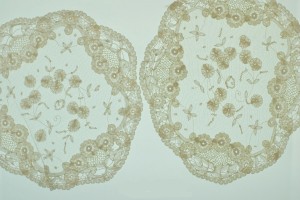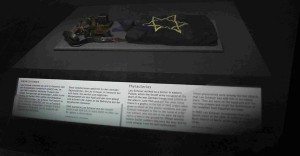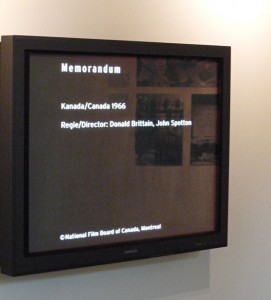
Two doilies from the Plesch family household, from the first half of the 20th century, given by Janos and Melanie Plesch in memory of Prof. Dr. Peter H. Plesch.
You can often find a number of Jewish Museum employees in the lunchtime crowd at the canteen of the European Patent Office at Hallesches Tor in Berlin. The food there is excellent; the noise, on the other hand, is excessive: rattling silverware, clattering dishes, and the voices of diners whirring together into one great drone.
In the dining room of the Berliner doctor family Plesch such a hubbub would have been unthinkable. Their secret: clatter-doilies. → continue reading
“Axis of the Holocaust” is the designation of one of three corridors in the museum’s basement. Display cabinets are inlayed in the wall. They contain photographs, pieces of writing, and objects that convey the stories of people who survived or were murdered in the Holocaust.
They contain photographs, pieces of writing, and objects that convey the stories of people who survived or were murdered in the Holocaust.
In one window lie phylacteries and a pouch with an embroidered Star of David. These objects belonged to Leo Scheuer. He gave them to the museum shortly before his death. → continue reading
 A police siren blares through the last rooms of the permanent exhibition. The source of the alarming noise is a film excerpt being displayed on a large screen.
A police siren blares through the last rooms of the permanent exhibition. The source of the alarming noise is a film excerpt being displayed on a large screen.
This section of the exhibition is about the Frankfurt Auschwitz trial that took place from December 1963 until August 1965. Former SS members of the Auschwitz concentration camp authority were tried for murder or for aiding and abetting murder. The litigation is regarded as a turning point in the way the National Socialist past was dealt with in the new Federal Republic. → continue reading


